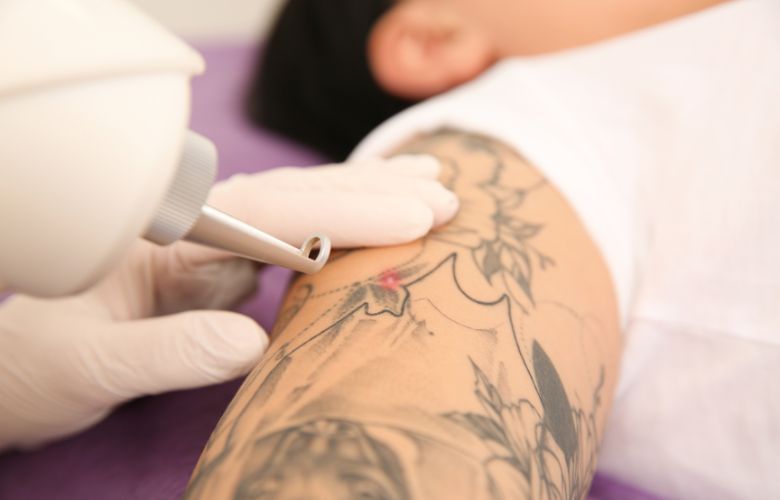The Empowering Effect of Tattoos
Tattoos have evolved from being merely cosmetic body art to potent representations of individuality, self-expression, and power. People are embracing tattoos as a way to reflect their individuality and confidently express themselves, which has led to a surge in their popularity in recent years. Tattoos have a profound psychological effect on people that extends beyond their aesthetic appeal. These effects frequently increase confidence and help people embrace their true selves. In this article, we will set out on an adventure to investigate the empowering power of tattoos, examining their psychological associations, the symbolism behind them, and even the transformative procedure of tattoo removal.
Exploring the Psychological Impact of Tattoos
 Unveiling the Connection Between Tattoos and Confidence
Unveiling the Connection Between Tattoos and Confidence
Tattoos have a remarkable connection with confidence. The act of adorning one’s body with meaningful ink becomes a visible statement of self-acceptance and personal empowerment. Tattoos serve as constant reminders of one’s values, beliefs, and experiences, fostering a sense of identity and pride. People frequently experience a boost in self-confidence and an improved sense of self-worth when they embrace their tattoos. Tattoos serve as a physical manifestation of a person’s journey and a celebration of what makes each person special.
Embracing Self-Acceptance through Body Art
Tattoos offer a profound avenue for self-acceptance and self-expression. They provide individuals with a medium to break free from societal norms and freely express their true selves. The process of selecting a tattoo design involves introspection and self-reflection, leading to a deeper understanding of one’s desires, values, and passions. By embracing their tattoos, individuals learn to embrace themselves fully, flaws and all, fostering a sense of self-acceptance that radiates confidence in all aspects of life. Tattoos become a celebration of personal stories and an embodiment of the courage to embrace one’s unique journey.
Tattoo as a Symbol of Personal Identity
 Ink Your Story: The Narrative Behind Tattoo Choices
Ink Your Story: The Narrative Behind Tattoo Choices
Every tattoo tells a story. From intricate designs to subtle symbols, each tattoo holds personal meaning and significance for the individual wearing it. The choice of a particular tattoo design often reflects a person’s life experiences, cultural heritage, or aspirations. By wearing these symbols on their bodies, individuals establish a visual representation of their personal narratives, strengthening their sense of identity and boosting their confidence in their unique life journey. Tattoos become a language of self-expression, speaking volumes about an individual’s values, passions, and dreams.
The Significance of Meaningful Tattoos in Boosting Confidence
Meaningful tattoos go beyond surface-level aesthetics; they hold deep emotional and psychological significance. These tattoos act as constant reminders of our own accomplishments, lessons learned, or cherished family members who have had an impact on our lives. By permanently etching these meaningful symbols onto their skin, individuals create a source of strength and inspiration that boosts their confidence. These tattoos become a visual affirmation of personal growth and resilience, empowering individuals to face life’s challenges with renewed courage. Meaningful tattoos turn into talismans that give people courage and a sense of purpose.
The Transformative Journey: How Tattoos Empower Individuals
 Body Art as a Form of Self-Expression and Empowerment
Body Art as a Form of Self-Expression and Empowerment
Tattoos provide a canvas for self-expression that extends beyond verbal communication. They allow individuals to communicate their values, passions, and beliefs to the world in a unique and visually captivating way. By expressing themselves through body art, individuals reclaim their personal narratives and assert their presence in society. This form of self-expression acts as a catalyst for empowerment, giving individuals the confidence to stand out and be seen for who they truly are. Tattoos become an emblem of personal empowerment and a declaration of individuality.
Breaking Stereotypes and Challenging Society’s Beauty Standards
Tattoos have the ability to subvert social norms regarding beauty and shatter stereotypes. In a world that often dictates how one should look or conform, tattoos serve as a powerful statement of individuality and defiance. They encourage individuals to embrace their bodies as canvases for self-expression, regardless of societal expectations. By defying these norms and proudly displaying their tattoos, individuals inspire others to embrace their uniqueness, fostering a culture of acceptance and empowerment. Tattoos become a rebellion against conformity, sparking conversations and promoting a celebration of diverse beauty.
Tattoo Removal: A New Chapter of Self-Empowerment
 Considering Tattoo Removal: Exploring Personal Motivations
Considering Tattoo Removal: Exploring Personal Motivations
While tattoos are intended to be permanent, personal circumstances and preferences can change over time, leading individuals to consider tattoo removal. The decision to remove a tattoo requires careful consideration. Motivations for tattoo removal may include personal growth, a change in values, or the desire for a fresh start. It is essential to explore these motivations and reflect on the significance of the tattoo before embarking on the removal process.
Understanding Tattoo Removal Options: Risks and Procedures
When considering tattoo removal, individuals have several options to choose from, each with its own set of risks, benefits, and procedures. It’s essential to have a comprehensive understanding of these options before making a decision. Let’s explore the most common tattoo removal methods in more detail:
Laser Tattoo Removal: The Gold Standard
Laser tattoo removal is the most popular and widely used method for removing tattoos. It involves using specialized lasers that emit high-intensity light pulses targeted at the tattooed area. The laser energy breaks down the tattoo ink into smaller fragments, allowing the body’s immune system to gradually eliminate them over time.
During the procedure, the tattooed area is numbed with a local anesthetic to minimize discomfort. The laser device is then applied to the skin, delivering short bursts of laser energy. The sensation during the procedure is often described as a rubber band snapping against the skin. The number of sessions required for complete tattoo removal varies depending on factors such as tattoo size, ink color, ink depth, and individual skin characteristics.
It’s important to note that laser tattoo removal is not a one-time procedure. Multiple sessions are usually required, typically spaced 6-8 weeks apart, to allow the skin to heal and the immune system to flush out the fragmented ink particles. Patience and adherence to the recommended treatment schedule are crucial for successful results.
While laser tattoo removal is generally safe and effective, there are some risks involved. These include temporary side effects such as redness, swelling, blistering, or mild discomfort after each session. In rare cases, there is a potential risk of scarring, skin texture changes, or pigmentation irregularities. However, with advancements in laser technology and experienced practitioners, the likelihood of these risks has significantly decreased.
Surgical Excision: Removing the Tattooed Skin
Surgical excision involves physically removing the tattooed skin through a surgical procedure. This method is typically suitable for smaller tattoos or specific cases where laser removal may not be as effective. During the procedure, the tattooed area is numbed with a local anesthetic, and the tattooed skin is cut out using a scalpel. The surrounding skin is then stitched back together, allowing it to heal over time.
Surgical excision offers the advantage of complete tattoo removal in one session. However, it may not be suitable for larger tattoos as it can result in more extensive scarring. The size and location of the tattoo, as well as the individual’s skin type, are important factors to consider when determining the feasibility of surgical excision.
After the procedure, it’s crucial to follow the aftercare instructions provided by the surgeon to ensure proper healing and minimize the risk of complications. Scarring is a common outcome of surgical excision, but it tends to fade over time and can be minimized with scar reduction techniques or treatments.
Other Tattoo Removal Methods: Less Common Alternatives
In addition to laser removal and surgical excision, there are other tattoo removal methods available, although they are less commonly used due to their associated risks and limitations. These methods include:
Dermabrasion: This technique involves mechanically sanding the tattooed skin layers using a rotating abrasive device. While it can effectively remove tattoo ink, it carries a higher risk of scarring, pigmentation changes, and inconsistent results. Dermabrasion is rarely recommended for tattoo removal nowadays.
Chemical Peels: This method involves applying acid solutions to the tattooed skin to remove the outer layers. However, tattoo ink is often deeply embedded in the skin, making chemical peels less effective for complete tattoo removal. Moreover, the risk of adverse reactions, scarring, and inconsistent results makes this method less favored.
It’s important to consult with a qualified dermatologist or reputable tattoo removal specialist to discuss the most suitable method for your specific tattoo and skin type. They can assess your tattoo and provide personalized recommendations based on factors such as size, ink color, location, and desired outcome.
Embracing Change: The Journey of Letting Go
Tattoo removal represents a journey of self-empowerment and embracing change. Whether you choose Melbourne laser tattoo removal, surgical excision, or any other method, it’s essential to approach the process with realistic expectations and a positive mindset. Removing a tattoo is not only a physical transformation but also an emotional and psychological one. It requires letting go of a visual reminder and allowing yourself to evolve and grow.
Throughout the tattoo removal journey, it’s crucial to follow the recommended treatment plan, attend all scheduled sessions, and adhere to proper aftercare instructions. Be patient, as complete tattoo removal may take several sessions, depending on various factors. Embrace the support of your tattoo removal specialist, who will guide you through the process and provide the necessary advice and guidance.
Remember, tattoo removal is a personal choice, and it can signify a fresh start, personal growth, or simply a change in preferences. By embracing the journey of tattoo removal, you empower yourself to move forward and embrace new possibilities, ultimately fostering a renewed sense of confidence and self-acceptance.
Conclusion: Embrace the Empowerment of Tattoos and Self-Expression
Tattoos have emerged as powerful tools of self-expression and personal empowerment. They provide individuals with a means to embrace their true selves, boost their confidence, and challenge societal norms. Through meaningful symbols and narratives, tattoos become transformative reminders of personal growth and resilience. Whether choosing to ink their bodies or embarking on a journey of tattoo removal, individuals can harness the empowering effect of tattoos to embrace their uniqueness, break free from societal constraints, and confidently navigate their life’s journey of self-discovery and transformation. So, let your ink tell your story, embrace your authenticity, and unlock the empowering effect of tattoos.


